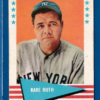Baseball Card Storage Boxes: Protecting Your Treasured Collection
Baseball card collecting is a beloved hobby that connects fans to the history and heroes of America’s pastime. Whether you’re an avid collector or a casual enthusiast, preserving and organizing your collection is essential. Baseball card storage boxes are indispensable tools that safeguard your cards while keeping them organized. In this article, we’ll explore the importance of these boxes, their various types, and how to choose the right one for your collection.
Why Baseball Card Storage Boxes Matter
Baseball card storage boxes serve multiple vital functions in the world of card collecting:
- Protection: The primary purpose of these boxes is to protect your cards from dust, moisture, sunlight, and physical damage. Storing cards in boxes helps maintain their condition and value.
- Organization: Storage boxes keep your collection organized, making it easy to locate specific cards, players, or sets. This is especially important if you have a large collection.
- Preservation: Storing cards in appropriate boxes prevents cards from bending, warping, or sticking together, ensuring their long-term preservation.
- Display: Some storage boxes are designed for display purposes, allowing you to showcase your favorite cards while keeping them safe.

Types of Baseball Card Storage Boxes
There are several types of baseball card storage boxes available, catering to different preferences and collection sizes:
- Shoeboxes: Many collectors start with shoeboxes. While not designed specifically for cards, they are affordable and readily available. You can add dividers or cardholders to keep cards organized within the shoebox.
- Cardboard Storage Boxes: These are sturdy, cardboard boxes designed for card storage. They come in various sizes to accommodate different card quantities, from 200-count to 5,000-count boxes.
- Plastic Boxes: Plastic storage boxes offer better protection against moisture and pests. They often have multiple compartments or rows to help organize cards effectively.
- Graded Card Boxes: If you collect professionally graded cards, there are specific storage boxes designed to hold graded slabs securely.
- Display Cases: For collectors who want to showcase their prized cards, display cases with UV-protective glass offer a stylish and protective option.
Choosing the Right Baseball Card Storage Box
When selecting a storage box for your baseball card collection, consider the following factors:
- Collection Size: Choose a box size that accommodates your current collection and allows room for future additions.
- Material: Plastic boxes are more durable and provide better protection against moisture compared to cardboard boxes.
- Dividers: If you want to keep cards organized within the box, look for boxes that come with dividers or consider purchasing dividers separately.
- Accessibility: Consider how easy it is to access cards within the box. Some boxes have removable lids for quick access, while others require you to remove the entire lid.
- Display Options: If you want to display some of your cards, explore options like display cases or boxes with clear lids.

Maintaining Your Collection
Regularly check your storage boxes to ensure cards remain in good condition. Keep boxes in a cool, dry place away from direct sunlight and extreme temperatures. Additionally, consider using silica gel packets or desiccant to absorb moisture and protect against humidity.
Baseball card storage boxes are the unsung heroes of card collecting. They not only safeguard your cherished collection but also help you stay organized and enjoy your cards for years to come. Whether you’re a seasoned collector or just starting, investing in quality storage solutions is a crucial step in preserving the rich history and memories encapsulated in your baseball cards.


